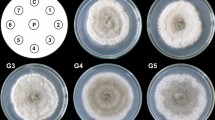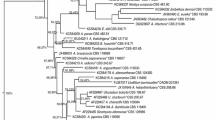Abstract
The mycelial culture of the mushroomPanaeolus papillonaceus showed high tolerance (150 μg/ml) of polyene antibiotics (nystatin, amphotercinin B) present in the growth medium and protoplast of the fungus regenerated normally in the presence of the antibiotics. Both antibiotics inhibited growth of other mushroom strains at concentrations from 10 μg/ml to 20 μg/ml. Because polyene antibiotics interact with free membrane sterol of the sensitive fungi, the sterol present in the mycelia ofP. papillonaceus was studied. Extraction of sterol from the mushroomP. papillonaceus required primary treatment of the dried mycelia with alkali, and only ergosterol was identified as present as the extracted sterol. No sterol or sterol conjugate (fatty acid ester) could be extracted directly from the mycelia by petroleum ether, chloroform, or methanol without prior alkali treatment. Homogenization of the mycelia and subsequent treatment of the homogenate with detergent or chaotropic ions did not release any sterol conjugate in the aqueous phase. The unique nature of the sterol component present in the mycelia ofP. papillonaceus was indicated.
Similar content being viewed by others
Literature Cited
Athar MA, Winner HI (1971) The development of resistance byCandida species to polyene antibioticsin vitro. J Med Microbiol 4:505–517
Ghosh AK, Sengupta S (1977) Studies on biochemistry of higher fungi. I. Submerged growth ofVolvariella volvacea in synthetic medium. J Food Sci Technol 14:6–10
Ghosh AK, Sengupta S (1978) Studies on biochemistry of higher fungi. II. Submerged growth of a few mushrooms in synthetic media. J Food Sci Technol 15:237–242
Hitchcok CA, Barett-Bee KJ, Russel NJ (1987) The lipid composition and permeability to azole in an azole and polyene resistant mutant ofCandida albicans. J Med Vet Mycol 25:29–37
Holz RW (1979) Nystatin, Amphotericin B and Filipin. In: Hahn FE (ed) Antibiotics, Vol. V/Part 2. Berlin, Heidelberg, New York: Springer-Verlag, pp 313–340
Hsuchen CC, Feingold DS (1974) Two types of resistance to polyene antibiotics inCandida albicans. Nature 251:656–659
Iijima Y, Shima KF, Yanagi, SO (1991) Protoplast fusion between compatible (A≠B≠) and incompatible (A≠B=, A=B≠, and A=B=) mating type monokaryons derived from Basidiomycetes of onePleurotus salmoneostramineus fruid body. Agric Biol Chem 55:1977–1983
Jae-Sung L, Iijima Y, Kobayashi H, Yanagi SO (1988) Release, regeneration and mutant induction ofPleurotus cornucopeae protoplast. Agric Biol Chem 52:1877–1878
Kawasumi T, Baba T, Yanagi S (1988) Protoplast fusion of incompatible mating type combination ofLentinus edodes. Agric Biol Chem 52:3197–3199
Lampen JO (1966) Interference by polyene antifungal antibiotics (especially nystatin and filipin) with specific membrane functions. Symp Soc Gen Microbiol 16:111–130
MacIntyre L, Ralston M (1954) Direct determination of serum cholesterol. Biochem J Proc 56:43
Mukherjee M, Sengupta S (1986) Mutagenesis of protoplasts and regeneration of mycelium in the mushroomVolvariella volvacea. Appl Env Microbiol 52:1412–1414
Mukherjee M, Sengupta S (1988) Isolation and regeneration of protoplasts fromTermitomyces clypeatus. Can J Microbiol 34:1330–1332
Munoz-Rivas A, Specht CA, Drummond BJ, Froeliger E, Novotny CP (1986) Transformation of the basidiomycete,Schizophyllum commune. Mol Gen Genet 205:103–106
Pikálek P, Necásaek J (1978) Detoxification of cycloheximide by resistant strain ofSchizophyllum commune. Folia Microbiol 23:84–87
Raper CA, Raper JR, Miller RE (1972) Genetic analysis of the life cycle ofAgaricus bisporus. 64:1088–1117
Traynor JD, Sardharwalla I, North J (1986) Biochemical analysis of the role of cytoplasmic ribosomes ofCoprinus cinereus in cycloheximide resistance. J Gen Microbiol 132:757–763
Veal D, Casselton LA (1985) Regulation of tryptophan metabolism inCoprinus cinereus—isolation and characterization of mutant resistant to 5-fluoroindole. Arch Microbiol 142:157–163
Weber MM, Kinsky SC (1965) Effect of cholesterol on the sensitivity ofMycoplasma laidlawii to the polyene antibiotic filipin. J Bacteriol 89:306–312
Author information
Authors and Affiliations
Rights and permissions
About this article
Cite this article
Mukherjee, M., Chakravarty, A.K. & Sengupta, S. Natural resistance of the mycelial culture of the mushroom,Panaeolus papillonaceus, towards growth inhibition by polyene antibiotics. Current Microbiology 27, 1–4 (1993). https://doi.org/10.1007/BF01576825
Issue Date:
DOI: https://doi.org/10.1007/BF01576825




